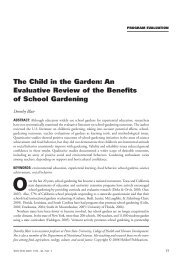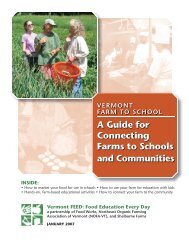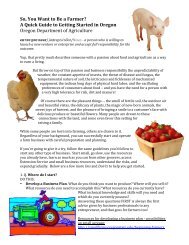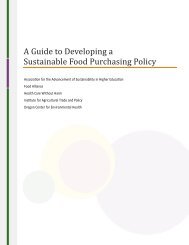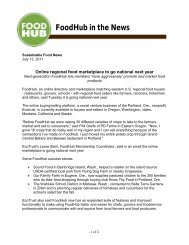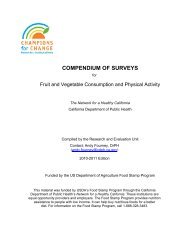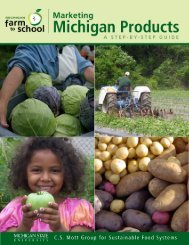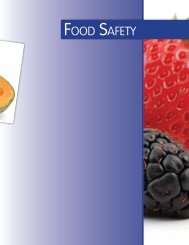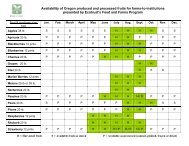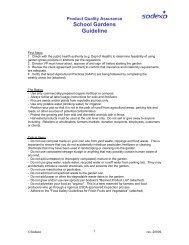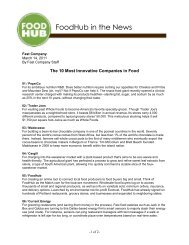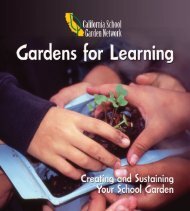eval report cover.indd - New Jersey Farm to School Network Wiki
eval report cover.indd - New Jersey Farm to School Network Wiki
eval report cover.indd - New Jersey Farm to School Network Wiki
You also want an ePaper? Increase the reach of your titles
YUMPU automatically turns print PDFs into web optimized ePapers that Google loves.
WSD-CA: WINTERS JOINT UNIFIEDSCHOOL DISTRICT, CALIFORNIAWinters Joint Unified<strong>School</strong> District, CAFree / reduced mealeligibility: 48%Total schools: 16Enrollment: 1,940Demographics:63.6 % Hispanic, 43.2% WhiteLocal product used in:Once a week salad bars offeredas USDA reimbursable mealsOther program components:In-class nutrition education,school gardens, farm <strong>to</strong>ursWinters’ <strong>Farm</strong> <strong>to</strong> <strong>School</strong> program was initiatedin 2002 as a pilot demonstration sitesupported through a grant from the W.K.Kellogg Foundation received by the Center for Food& Justice, Occidental College. The program <strong>eval</strong>uationwas conducted by the University of California SustainableAgriculture Research and Education Program(SAREP) from 2002-04. In the first year of the project,one school implemented the farm fresh salad bar(Rominger Elementary). In the second year, WaggonerElementary also started implementation. Evaluationcomponents included:<strong>School</strong> District Produce Purchases: Monthly data on<strong>to</strong>tal fruit and vegetable purchases for the district andfor the two schools was collected from invoices andyear-end budgets.<strong>School</strong> Meal Participation Rates: Average daily participation collected from both schools,2002-04 <strong>to</strong> compare participation on salad bar and non-salad bar days, as well as salad barand hot meal option.Student Food Choices: Collected food service daily production records <strong>to</strong> analyze the numberof servings of fruits/vegetables per student in the two schools – salad bar and hot mealoption.<strong>School</strong> Food Service Fiscal Feasibility: Analysis of school food service budgets for twoschools for the 2002-04 school years <strong>to</strong> determine the costs and feasibility of maintaining asalad bar program.Challenges/Lessons Learned:Interviews with key stakeholders, including the salad bar coordina<strong>to</strong>r, the food service direc<strong>to</strong>r,kitchen personnel, farmers, teachers, and principals were conducted.Th e two year trend data available from WSD-CA was valuable in understanding how theprogram operated in those years. In 2006, Winters Joint Unifi e d <strong>School</strong> District hired anew food service direc<strong>to</strong>r, who continued with the once a week salad bar program, but wasnot buying the salad bar foods from the local farmers. Th e reasons for discontinuing relate<strong>to</strong> the cost of the food and associated labor. Due <strong>to</strong> previous connections made with localfarms, some farmers sometimes offered excess crops <strong>to</strong> the school district <strong>to</strong> be served <strong>to</strong>students.Feenstra Gail and Ohmart Jeri, UC Sustainable Agriculture Research & Education Program. Yolo County <strong>Farm</strong><strong>to</strong> <strong>School</strong> Evaluation Report. 2005Conclusions <strong>Farm</strong> <strong>to</strong> <strong>School</strong> and Program RecommendationsProfilesFeenstra Gail and Ohmart Jeri. Yolo County <strong>Farm</strong> <strong>to</strong> <strong>School</strong> Evaluation Report for the California <strong>Farm</strong> <strong>to</strong> <strong>School</strong>Program, Center for Food & Justice, Occidental College. Oc<strong>to</strong>ber 2004.www.farm<strong>to</strong>school.org 83



